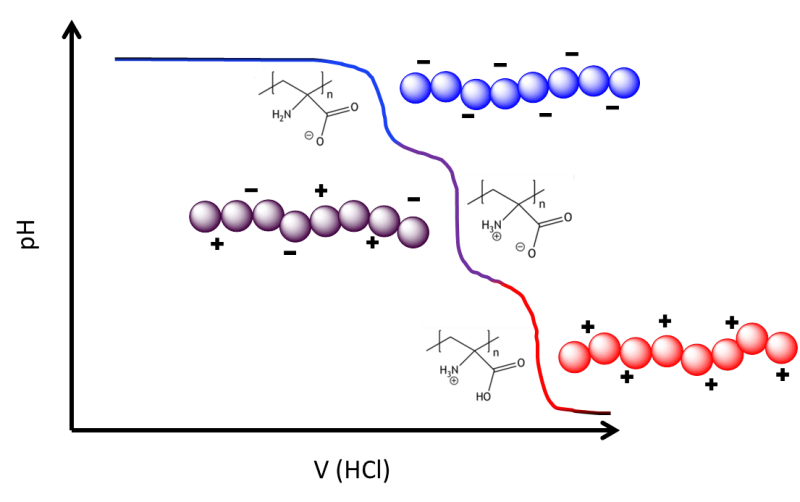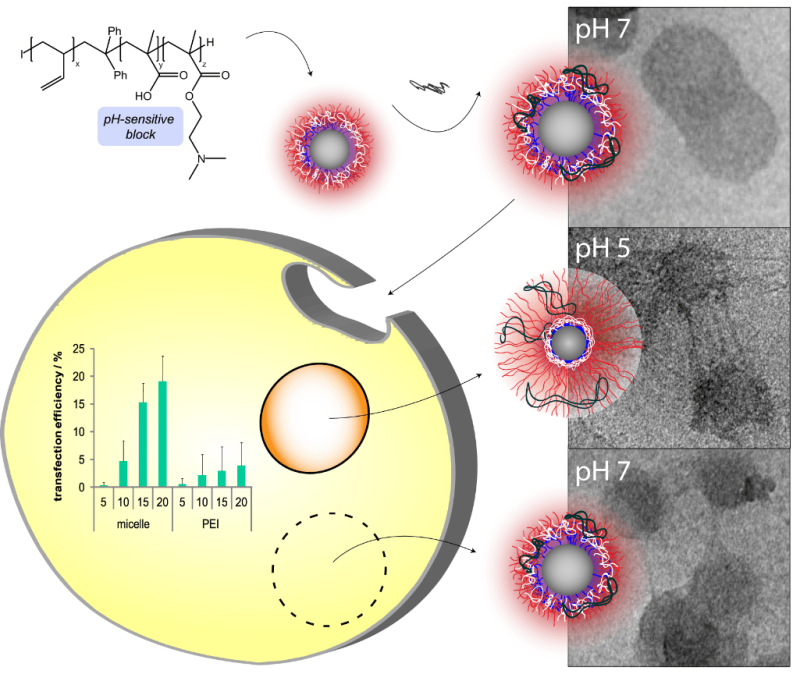Polyelectrolytes
We are interested in the synthesis and characterization of novel polyelectrolytes, in particular polyampholytes with tunable charge density and overall charge. One example is poly(tert-butoxycarbonylaminomethylacrylate) (PtBAMA), a derivative of polydehydroalanine (PDha). This material is synthesized starting from 2-tert-butoxycarbonylaminomethylacrylate (tBAMA) using free radical polymerization (FRP) and nitroxide mediated polymerization (NMP). Due to the presence of orthogonal protective groups the resulting polymers can be selectively deprotected to yield either a polyanion (poly(tert-butoxycarbonylaminoacrylic acid), PtBAA) or a polycation (poly(aminomethylacrylate), PAMA). On the other hand, deprotection of both the amino- and the carboxyl-functionality in a sequential manner leads to the potential polyzwitterion polydehydroalanine (PDha). We investigated the pH-dependent solution behavior of PtBAA, PAMA, and PDha in aqueous solution by ζ-potential measurements and (in parts) potentiometric and turbidimetric titrations. Currently, the use of such materials in interpolyelectrolyte complex formation, electrospinning, miniemulsion polymerization, and in thin films is in the focus of our research.
See also: U. Günther, L. V. Sigolaeva, D. V. Pergushov, F. H. Schacher, "Polyelectrolytes with Tunable Charge Based on Polydehydroalanine: Synthesis and Solution Properties", Macromol. Chem. Phys. 2013, 214, 2202-2212
Image: Felix H. SchacherRegarding the application of polyelectrolytes (mostly cationic examples) or interpolyelectrolyte complexes, the controlled non-viral delivery of genetic material into cells has been of intense interest during the last three decades, yet the ideal delivery agent featuring utmost transfection efficiency and low cytotoxicity still has to be developed. We could demonstrate that multicompartment micelles from stimuli-responsive triblock terpolymers, poly(butadiene-block-poly(methacrylic acid)-block-poly(2-(dimethylamino)ethyl methacrylate) (BMAAD), are promising candidates. The structures exhibit a patchy shell, consisting of amphiphilic (interpolyelectrolyte complexes, MAA and D) and cationic patches (excess D), generating a surface reminiscent to those of certain viruses and capable of undergoing pH-dependent changes in charge stoichiometry. After polyplex formation with plasmid DNA, superior transfection efficiencies can be reached for both adherent cells and human T-lymphocytes. Compared to the gold standard PEI, remarkable improvements and a number of advantages were identified for this system, including increased cellular uptake and an improved release of the genetic material, accompanied by fast and efficient endosomal escape. Furthermore, high sedimentation rates might be beneficial regarding in vitro applications.
See also: A. C. Rinkenauer, A. Schallon, U. Günther, M. Wagner, E. Betthausen, U. S. Schubert, F. H. Schacher, "A Paradigm Change: Efficient Transfection of Human Leukemia Cells by Stimuli-Responsive Multicompartment Micelles", ACS Nano2013, accepted for publication (DOI: 10.1021/nn402072d)
Image: Felix H. Schacher
